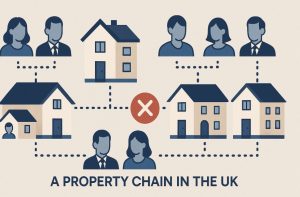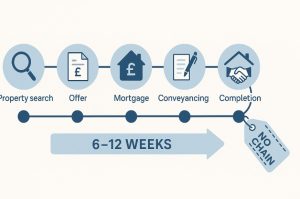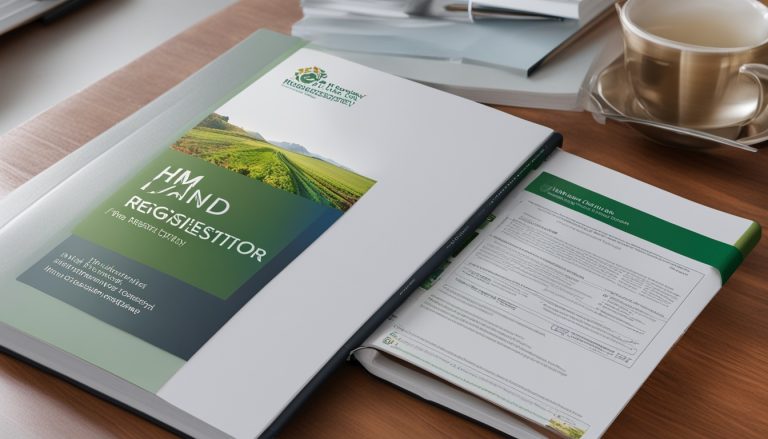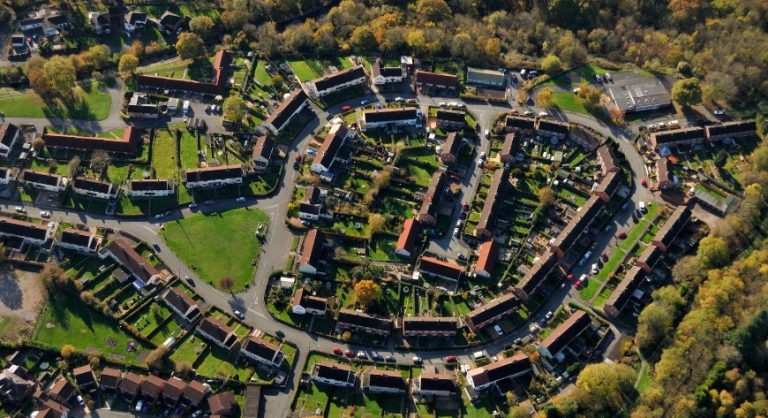Buying a house in the UK can be a complex and time-consuming process. One of the most significant factors affecting how long the purchase takes is whether the property is part of a chain.
When there is no chain involved, the process can be much faster and more straightforward. This blog explores how long it typically takes to buy a house with no chain, why it can be quicker, and what steps are involved.
What is a Property Chain?

A property chain is a series of linked house purchases and sales, where each transaction depends on another completing. If one part of the chain fails, it can delay or cancel the entire process.
For example, if a buyer is relying on selling their current home before purchasing a new one, and their buyer pulls out, everyone in that chain could be affected.
In contrast, a “no chain” situation arises when:
- The buyer is not selling a home to fund the purchase (e.g. first-time buyer)
- The seller has no onward purchase (e.g. they are moving into rented accommodation or a care home)
- The property is vacant, such as new-build homes or probate sales
These circumstances often simplify the buying process significantly.
Why No Chain Matters in the Home Buying Process?
Buying a property without a chain removes the reliance on external sales or purchases. This offers several benefits that can speed up the entire process and reduce stress.
Benefits of a no chain transaction include:
- Faster completion times
- Fewer administrative complications
- Lower risk of the sale falling through
- Less negotiation across multiple parties
- Greater control over scheduling key stages
These advantages make no chain properties highly attractive, particularly in competitive markets.
What Are the Typical Timelines for Buying a No Chain House?

The timeline for buying a house with no chain is typically shorter than that of a standard property transaction. While individual circumstances can vary, buyers can generally expect the process to take between 6 and 12 weeks, compared to 4 to 6 months for chain-involved purchases.
Here’s a detailed look at each stage of the process and how the absence of a chain helps to streamline each one.
1. Property Search (1–3 months)
Even in a no chain scenario, the initial property search remains the most unpredictable phase. It depends heavily on the current market conditions, property availability, and buyer preferences. However, buyers with no property to sell can act more quickly when they find a suitable home.
Buyers with no chain benefit from:
- More flexibility in viewing times
- Freedom to make immediate offers
- Increased appeal to sellers due to simplicity
In competitive markets, chain-free buyers often have an advantage, which can reduce the time it takes to secure a property.
2. Offer and Negotiation (1–2 weeks)
Once the buyer identifies the right property, the offer process usually moves quickly. In the absence of a chain, the seller may be more inclined to accept an offer promptly, especially from buyers ready to proceed without waiting for another property sale.
Key factors that speed up this stage:
- No dependency on the buyer’s home sale
- Faster communication between buyer, seller, and estate agents
- Reduced risk of delays or fall-throughs due to other parties
Sellers often prioritise offers from chain-free buyers, especially if they are under pressure to sell or wish to move quickly.
3. Conveyancing and Surveys (4–6 weeks)
Conveyancing is the legal process of transferring ownership from the seller to the buyer. This stage typically takes four to six weeks in a no chain transaction, as there are fewer stakeholders and less scheduling complexity.
During this stage, the buyer’s solicitor will:
- Order local authority, environmental, and drainage searches
- Review the contract pack from the seller’s solicitor
- Raise pre-contract enquiries
- Check the legal title and restrictions on the property
A property survey is also commissioned around this time to assess the condition of the building. If no major issues arise, the buyer and solicitor can proceed without pause.
Without a chain, conveyancers are only focused on one transaction. This can reduce communication lags, speed up paperwork, and eliminate common delays caused by coordinating multiple parties.
4. Mortgage Approval (2–4 weeks)
Buyers who need a mortgage approval will typically receive a formal offer within two to four weeks. The lender needs to verify the buyer’s financial position and carry out a valuation of the property.
While mortgage approval can sometimes be a bottleneck, in a no chain scenario:
- The valuation is focused on one property, reducing complications
- The process is simpler and quicker due to reduced dependency on sale proceeds
- Buyers can progress faster if they already have a mortgage agreement in principle
Having all financial documents (bank statements, payslips, ID) ready at the outset can help prevent unnecessary delays.
5. Exchange of Contracts (1–2 weeks)
After conveyancing is complete and the mortgage offer is received, the buyer and seller will exchange contracts. This stage formalises the agreement and makes the transaction legally binding.
In a no chain transaction:
- Both parties can agree on a suitable exchange date without needing to coordinate with other buyers or sellers
- There is greater control over timelines
- Issues like matching completion dates across multiple transactions are eliminated
Typically, exchange takes place around one to two weeks after the mortgage is confirmed and all searches and legal checks are complete.
6. Completion (1–2 weeks)
Completion is the final step, where funds are transferred and the buyer receives the keys to their new home. In chain-involved sales, this step is often delayed due to coordination issues. In a no chain transaction, however, completion can often happen within a few days of exchanging contracts.
The completion date is agreed upon by both parties, and because there are no other transactions to align with, there’s far more flexibility.
Common scenarios for no chain completions include:
- Vacant properties ready for immediate move-in
- Sellers relocating to rented accommodation or second homes
- New-build homes with flexible developer handovers
Overall Timeline Breakdown
Here is a visual summary of each stage and how long it generally takes in a no chain purchase:
| Stage | Estimated Duration | Details |
| Property Search | 1–3 months | Varies by market conditions and preferences |
| Offer & Negotiation | 1–2 weeks | Faster decisions and fewer dependencies |
| Conveyancing & Surveys | 4–6 weeks | Reduced legal complexity without a chain |
| Mortgage Approval | 2–4 weeks | Simplified by lack of onward sale |
| Exchange of Contracts | 1–2 weeks | Easier scheduling between buyer and seller |
| Completion | 1–2 weeks | Often flexible; quicker access to the home |
| Total Timeframe | 6–12 weeks | Typically half the time of a chain transaction |
What Are the Factors That Influence the Timeline for a No Chain House Purchase?

Even without a chain, several issues can influence how quickly a purchase completes.
Legal and Survey Delays
Problems in the property’s legal history, such as unclear boundaries or missing planning permissions, can slow down conveyancing. Survey results might reveal structural issues, prompting renegotiation or further inspection.
Mortgage Lender Efficiency
Some lenders are more efficient than others. Delays often arise due to incomplete paperwork or backlogs in processing.
- Choosing a lender with strong reviews for processing time is essential
- Working with a mortgage broker can reduce back-and-forth by ensuring documents are submitted correctly
Buyer and Seller Responsiveness
The speed of communication can make a significant difference. Transactions slow when:
- Buyers delay responding to solicitor queries
- Sellers are unprepared with required documentation
- Holidays or business hours affect solicitor availability
Buyers can improve responsiveness by:
- Setting up email alerts from their solicitor or estate agent
- Allocating time to promptly read and respond to requests
- Using digital signing platforms where available
Comparing No Chain vs Chain Property Transactions
To better understand how no chain purchases differ from typical property chains, here’s a comparison of both:
| Category | With Chain | No Chain |
| Number of Parties | 3–6+ | 1–2 |
| Risk of Collapse | High | Low |
| Coordination Required | Extensive | Minimal |
| Timeline | 4–6 months | 6–12 weeks |
| Stress Level | Higher | Lower |
| Communication Complexity | Multi-layered | Straightforward |
These comparisons demonstrate why no chain transactions are preferred by many UK homebuyers when time and certainty are top priorities.
What Are the Tips to Speed Up the No Chain Buying Process?

Even when buying a property with no chain — which is typically faster and more straightforward — delays can still occur. Issues such as slow paperwork, lender backlogs, or legal queries can extend timelines unnecessarily. To avoid such pitfalls and complete your purchase as swiftly as possible, it’s essential to take a proactive approach from the outset.
Below are key tips to help ensure your no chain home-buying process stays on track and moves forward efficiently.
Instruct a Solicitor Early
One of the most effective ways to gain a head start is by appointing your solicitor or conveyancer as soon as you start your property search — not after an offer has been accepted. A solicitor can conduct early ID checks, open a case file, and prepare for quick action when you find the right property.
Doing this enables you to:
- Begin initial paperwork without delay
- Show sellers and estate agents you are a serious, prepared buyer
- Start necessary legal checks as soon as the offer is accepted
Solicitors familiar with no chain transactions will also know how to fast-track essential steps without compromising due diligence.
Obtain a Mortgage Agreement in Principle
If you are not a cash buyer, securing a mortgage agreement in principle (AIP) early in the process can significantly reduce delays. An AIP confirms how much a lender is likely to offer you and proves to estate agents and sellers that you are financially ready to proceed.
An AIP helps:
- Speed up the formal mortgage application once a property is chosen
- Strengthen your negotiating position
- Avoid wasting time viewing properties beyond your borrowing limit
Buyers who have an AIP can proceed to full mortgage approval quickly, usually within days of having their offer accepted.
Be Financially and Administratively Prepared
Having all financial and identification documents ready is crucial to avoid unnecessary back-and-forth with your solicitor or mortgage lender. Lack of documentation is one of the most common causes of delays in property transactions.
Prepare and organise the following:
- Proof of identity (passport, driving licence)
- Proof of address (utility bill, bank statement)
- Proof of deposit (bank statement or gifted deposit letter)
- Employment and income documents (payslips, tax returns if self-employed)
- Mortgage agreement in principle
Responding promptly to requests and submitting documents in the correct format also keeps your application moving smoothly.
Commission a Survey Early
Once your offer is accepted, instruct your surveyor promptly. Waiting to schedule the survey can create unnecessary bottlenecks, particularly if the property is older or non-standard in construction.
Depending on the lender’s requirements, you may need:
- A basic valuation (for the lender)
- A homebuyer’s report (suitable for most modern homes)
- A full structural/building survey (recommended for older or altered properties)
Delays in obtaining survey results can postpone the exchange of contracts. Commissioning a survey early gives you time to review the findings, obtain repair quotes if needed, or renegotiate if any issues arise.
Maintain Clear and Frequent Communication
Clear communication between you, your solicitor, mortgage broker, estate agent, and surveyor is key to a seamless no chain transaction. Keep all parties updated and don’t hesitate to follow up if progress appears to be slowing.
Ways to enhance communication:
- Schedule weekly check-ins with your solicitor or estate agent
- Use email and phone to respond quickly to enquiries
- Request regular progress updates from all professionals involved
Being polite but assertive can ensure that your case receives the attention it deserves, especially during busy periods.
Choose Professionals With a Track Record of Efficiency
The professionals you choose can make or break the pace of your home purchase. Always opt for experienced conveyancers, mortgage brokers, and estate agents who have a solid reputation for handling no chain transactions.
Look for:
- Positive online reviews
- Personal recommendations from friends or family
- Transparent communication and quick response times
- Clearly defined timeframes for key stages
Choosing a conveyancer who uses modern digital systems can also accelerate the process. Some firms offer online document signing, case tracking portals, and automated updates, which reduce delays associated with traditional paper-based processes.
Conclusion
For buyers seeking a smoother and faster property purchase, a no chain transaction offers clear advantages. While it’s not entirely free of delays or complications, removing the chain reduces many of the common risks and speeds up the process significantly. With the right preparation and professional support, completing a no chain purchase in 6 to 12 weeks is a realistic goal.
FAQs About Buying a House With No Chain
What does “no chain” mean when buying a house?
It means the buyer and/or seller are not relying on the sale or purchase of another property to complete the transaction.
Can you complete faster if there’s no chain involved?
Yes, no chain purchases typically complete much faster due to fewer parties and less coordination.
Is buying a house with no chain always quicker?
While generally quicker, delays can still occur due to legal, financial, or survey-related issues.
Are there fewer risks with a no chain property purchase?
Yes, there is a lower risk of collapse since the transaction isn’t dependent on others in a chain.
Does having a mortgage slow down a no chain purchase?
It can, but with prompt documentation and a proactive lender, the impact can be minimised.
How long does conveyancing take with no chain?
On average, 4 to 6 weeks, depending on the complexity of the transaction and responsiveness of all parties involved.
What can cause delays even in a no chain transaction?
Common causes include survey issues, legal title problems, or delays from mortgage lenders.






